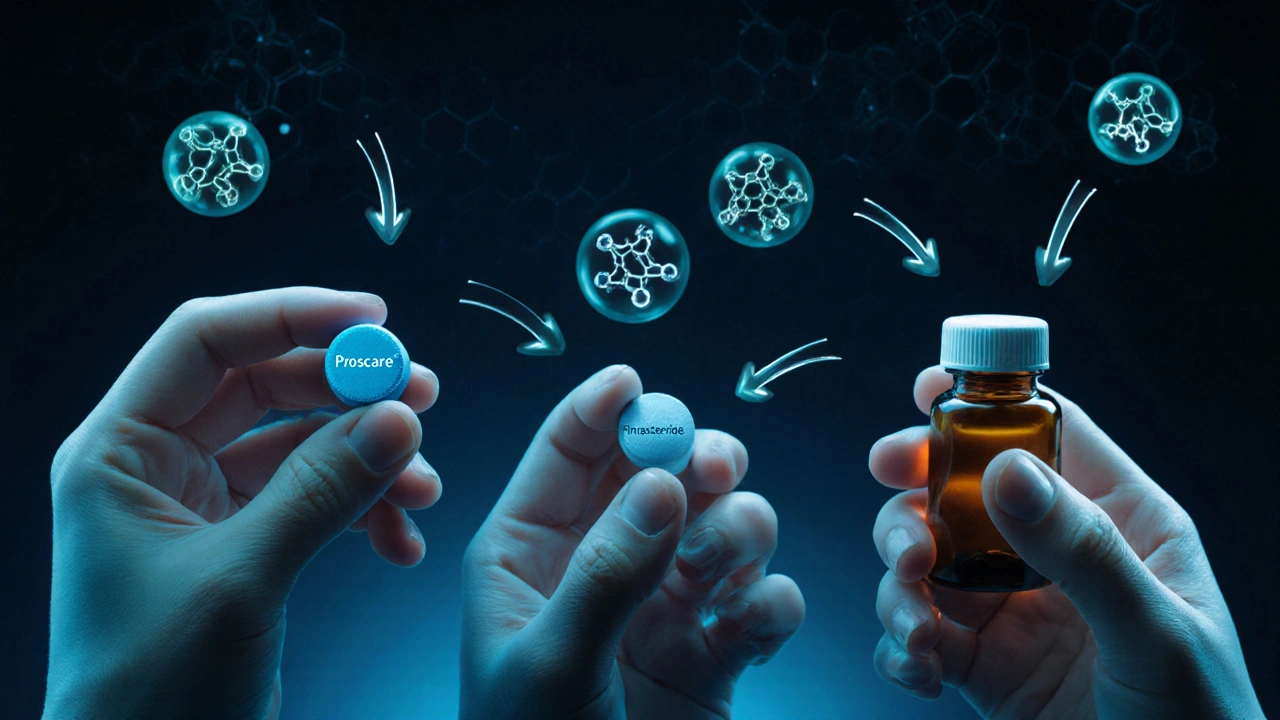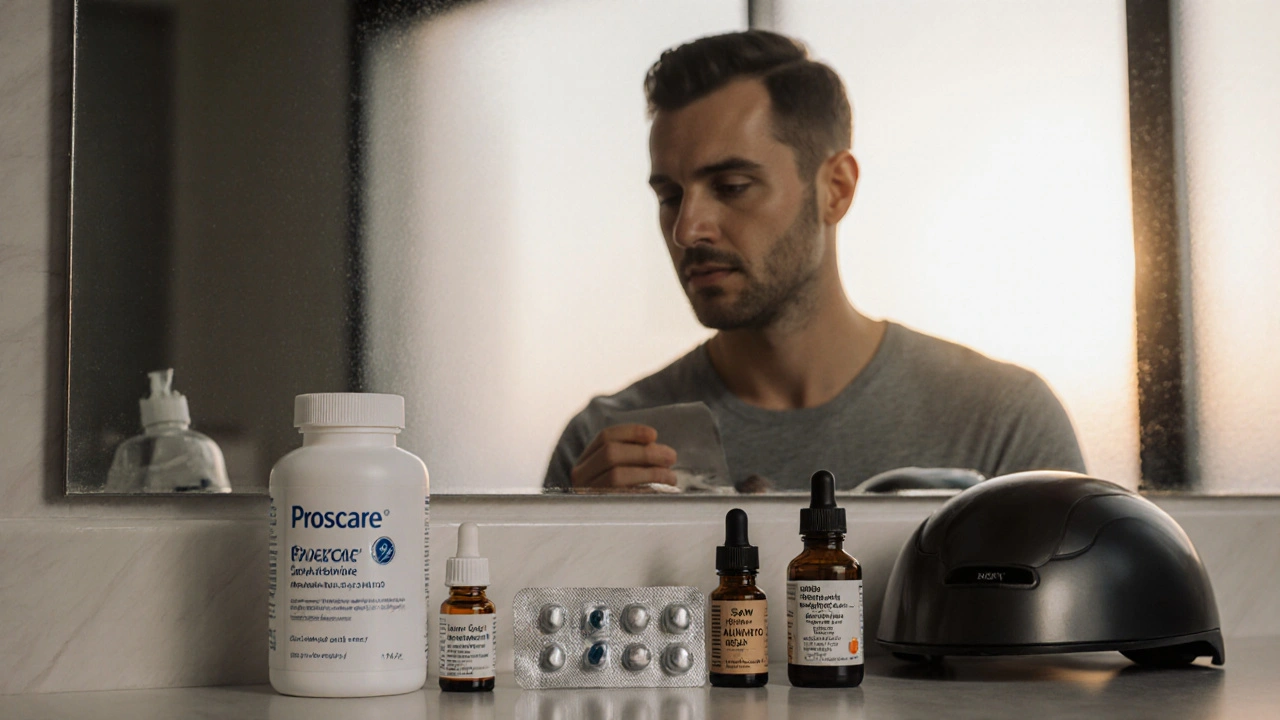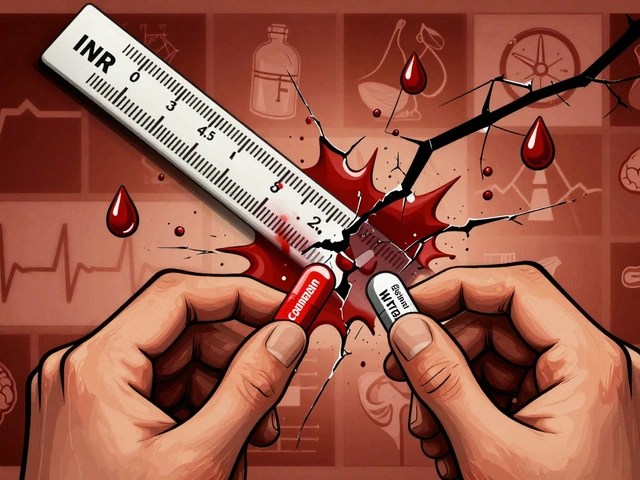Hair Loss Treatment Selector
Find Your Best Hair Loss Treatment
Answer a few quick questions to get a personalized recommendation based on your priorities, budget, and tolerance for side effects.
When you’re battling hair thinning, the market is full of pills, lotions, and gadgets. Picking the right option feels like a guessing game, especially if you’ve heard the name Proscare a branded Finasteride tablet approved for male‑pattern baldness (MPB) and wonder how it stacks up against other choices. This guide breaks down the most common alternatives, lays out the pros and cons, and gives you a clear path to decide what fits your scalp, budget, and lifestyle.
Key Takeaways
- Proscare delivers 1mg of Finasteride daily, targeting DHT production at its source.
- Generic Finasteride offers the same efficacy at a lower price but may lack brand‑level quality controls.
- Dutasteride blocks two enzymes, giving stronger DHT reduction, but carries higher sexual side‑effect risk.
- Topical Minoxidil works from the outside, suitable for combo therapy but slower to show results.
- Natural extracts like Saw Palmetto and Pumpkin Seed Oil are safe adjuncts, though clinical support is modest.
What Is Proscare (Finasteride) Exactly?
Proscare is a prescription‑only oral tablet containing 1mg of Finasteride. Finasteride inhibits the enzyme 5‑alpha‑reductase typeII, which converts testosterone into dihydrotestosterone (DHT). DHT is the main driver of follicular miniaturisation in MPB. By lowering scalp DHT levels by roughly 70%, Proscare can halt hair loss and promote regrowth in 60-70% of men after 12months.
Key attributes:
- Dosage: 1mg daily (tablet)
- Onset of noticeable effect: 3-6months
- Common side effects: reduced libido, mild erectile difficulty, occasional breast tenderness
- Contra‑indications: women who are or may become pregnant, men with prostate cancer history
Popular Alternatives to Proscare
Below is a quick snapshot of the most frequently discussed alternatives.
- Generic Finasteride - chemically identical to Proscare, often 30‑70% cheaper.
- Propecia - the original brand name for 1mg finasteride, still sold in many markets.
- Dutasteride - a 0.5mg tablet that blocks both typeI and typeII 5‑alpha‑reductase, marketed as Avodart for benign prostatic hyperplasia but used off‑label for hair loss.
- Minoxidil - a 2% (women) or 5% (men) topical solution that dilates blood vessels, stimulating follicle activity.
- Saw Palmetto - a plant extract that mildly inhibits 5‑alpha‑reductase, sold as capsules or gummies.
- Pumpkin Seed Oil - rich in phytosterols, shown in a 2022 randomized trial to increase hair count by 40% after 24weeks.
- Low‑Level Laser Therapy (LLLT) - handheld or helmet‑style devices emitting red light (630‑670nm) that boost cellular metabolism in follicles.

How to Compare: Decision Criteria
To make a fair call, weigh each option against the same set of attributes. The table below uses six criteria that matter most to men with MPB:
- Mechanism of action - how the product lowers DHT or stimulates growth.
- Clinical efficacy - % of users seeing measurable regrowth.
- Onset speed - months until visible improvement.
- Side‑effect profile - frequency and severity of adverse events.
- Cost per month (AUD) - average price in 2025 Australian market.
- Convenience - daily pill, topical application, or device usage.
Side‑by‑Side Comparison Table
| Product | Mechanism | Avg. Regrowth % | Onset | Common Side‑effects | Cost / month | Convenience |
|---|---|---|---|---|---|---|
| Proscare | 5‑α‑reductase II inhibition | 65% (hair count ↑) | 3-6mo | Libido ↓, occasional breast tenderness | $45 | Pill once daily |
| Generic Finasteride | Same as Proscare | 64% | 3-6mo | Similar to brand | $12 | Pill once daily |
| Dutasteride | 5‑α‑reductase I&II inhibition | 75% | 2-4mo | Higher sexual dysfunction rate | $38 | Pill once daily |
| Minoxidil (5%) | Vasodilation → follicle stimulation | 45% | 4-8mo | Scalp irritation, unwanted facial hair | $30 | Apply twice daily |
| Saw Palmetto | Weak 5‑α‑reductase inhibition | 20‑30% | 6-12mo | Generally mild; GI upset possible | $15 | Capsule daily |
| Pumpkin Seed Oil | Phytosterol‑mediated DHT reduction | 35% | 6-10mo | Rare; mild digestive changes | $20 | Oil 2ml daily |
| Low‑Level Laser Therapy | Photobiomodulation → ATP boost | 40% | 3-5mo | None reported in studies | $120 (device) / month ≈ $10 (lease) | 5‑min session 3×/week |
Which Option Is Best for Different Needs?
1. If you want the strongest evidence and are comfortable with a daily pill, Proscare or a generic finasteride give you the best cost‑to‑effect ratio. The brand may feel safer in terms of consistent tablet weight and FDA‑approved labeling, but the generic saves a lot of money.
2. If you’ve tried finasteride and hit a plateau, consider stepping up to dutasteride. It cuts DHT by up to 90% but you should discuss sexual side‑effect risk with a doctor.
3. If you dislike oral medication, a combo of minoxidil (topical) plus a natural supplement (saw palmetto or pumpkin seed oil) can deliver modest gains without systemic hormone changes.
4. If you have a low budget but still want a pharmacologic effect, the generic finasteride at $12 a month is hard to beat. Just verify the supplier’s quality certifications.
5. If you want a non‑drug, low‑risk approach, LLLT devices are safe and can be used alongside other treatments. The upfront cost is higher, but there are leasing programs that bring monthly outlay down to $10.

Potential Pitfalls and How to Avoid Them
- Skipping the doctor’s check - Even though finasteride is widely used, a baseline prostate‑specific antigen (PSA) test helps rule out underlying issues.
- Stopping abruptly - Discontinuing finasteride often leads to a rapid loss of any regrown hair within 6-12months. Tapering isn’t always required, but plan a transition.
- Mixing too many products - Using minoxidil, finasteride, and a laser device simultaneously can cause scalp irritation. Start one, assess tolerance, then add another.
- Ignoring side‑effects - Sexual side effects may improve after a few months, but if they persist, discuss dose reduction or alternative.
- Buying unregulated “online” pills - Counterfeit finasteride tablets contain either no active ingredient or the wrong dose. Stick to licensed pharmacies.
How to Start a Treatment Plan
- Consult a dermatologist or GP - Get a diagnosis, discuss family history, and rule out other scalp conditions.
- Choose your first‑line option - Many start with Proscare or a reputable generic finasteride.
- Set realistic expectations - Expect a 3‑month waiting period before you can gauge progress.
- Track results - Take standardized photos every 4weeks and note any side effects.
- Adjust after 6months - If regrowth stalls, discuss adding minoxidil or moving to dutasteride.
Frequently Asked Questions
Is Proscare the same as Propecia?
Both contain 1mg of finasteride, but Proscare is marketed in Australia under a different brand name. The clinical effect is identical; the main difference is packaging and price.
Can I combine finasteride with minoxidil?
Yes. Most dermatologists recommend the combo because they act on different pathways: finasteride lowers DHT systemically, while minoxidil stimulates follicle blood flow locally. Start with one, then add the other after 4-6 weeks.
Are natural supplements like saw palmetto effective?
Evidence is mixed. Small trials show a 20‑30% improvement, which is modest compared to finasteride. They’re safe for most men and can be useful as adjuncts, but don’t rely on them alone for noticeable regrowth.
What’s the biggest downside of dutasteride?
Higher incidence of sexual side effects - up to 12% report reduced libido or erectile difficulty versus 5‑7% with finasteride. Some users also notice a slight increase in breast tenderness.
Do laser helmets require a prescription?
No prescription is needed for over‑the‑counter LLLT devices in Australia, but it’s wise to confirm the device is FDA‑cleared or TGA‑registered for safety.
Bottom line: Proscare (Finasteride) remains the gold‑standard for medically proven MPB treatment, but alternatives give you room to tailor cost, safety, and convenience. Choose the path that matches your health profile, budget, and willingness to handle side effects, and you’ll be on a clearer road to fuller hair.







Tyler Heafner
October 12, 2025 AT 18:49When embarking upon a hair‑loss regimen, strict adherence to the prescribed dosage and scheduled follow‑ups is paramount. Ensure you obtain a baseline PSA level and document any changes in hair density with calibrated photographs. The pharmacokinetics of finasteride demand daily ingestion to maintain consistent DHT suppression. Should side‑effects emerge, a structured taper under medical supervision is advisable rather than abrupt cessation. Ultimately, disciplined compliance yields the most reliable regrowth outcomes.
Gene Nilsson
October 20, 2025 AT 21:29It is ethically indefensible to self‑prescribe hormonal modulators without a qualified professional's oversight. The moral responsibility one bears when altering endocrine pathways cannot be overstated; negligence may precipitate irreversible sequelae. Moreover, the commercial exploitation of vulnerable individuals seeking aesthetic solutions breaches basic principles of beneficence. In sum, the only defensible path is a physician‑guided protocol, lest we succumb to the tyranny of unchecked consumerism.
Vintage Ireland
October 29, 2025 AT 00:09Hey, I get where you’re coming from – the sheer amount of options can feel overwhelming. Think of it as a personal experiment: start with a single evidence‑based method, track your progress, then decide if you want to layer something else. Patience is a virtue, especially when hair cycles are involved.
Anshul Gupta
November 6, 2025 AT 02:49Another “miracle” pill and the hype train keeps rolling. The side‑effect disclaimer is always tucked in the fine print, as usual.
Maryanne robinson
November 14, 2025 AT 05:29Let’s break this down step by step, because the journey from thin strands to a fuller crown isn’t a sprint, it’s a marathon, and you deserve a clear roadmap. First, anchor yourself with a reputable source for Finasteride, whether it’s Proscare or a certified generic; the active ingredient is identical, and the difference lies mainly in price and packaging consistency. Second, schedule a baseline appointment with a dermatologist to capture high‑resolution photos and a PSA reading – this data becomes your compass for measuring progress. Third, commit to a daily regimen without missing doses; the pharmacodynamics of 5‑α‑reductase inhibition require steady plasma levels to keep DHT in check. Fourth, monitor for any adverse reactions – reduced libido, mild breast tenderness, or mood changes – and report them promptly; early intervention can mitigate long‑term issues. Fifth, after three months, assess tangible changes: count the number of hairs in a defined 1 cm² area or use a handheld trichometer if available. Sixth, if the response is suboptimal, consider adjuncts such as topical Minoxidil at 5% applied twice daily; this combination targets both systemic DHT suppression and local follicular stimulation. Seventh, keep a simple journal – date, dosage, side‑effects, and any visual observations – this creates a feedback loop that feeds your physician’s decisions. Eighth, remain realistic; most men see 30‑65 % regrowth, not a thunderbolt of hair overnight. Ninth, stay consistent with follow‑up visits every six months to recalibrate your treatment plan, especially if you’re contemplating a switch to Dutasteride for stronger DHT blockade. Tenth, protect your scalp from excessive UV exposure and harsh chemicals – a healthy environment maximizes the benefits of any medication. Eleventh, avoid the temptation of unregulated online pills; counterfeit versions may contain zero active ingredient or harmful contaminants. Twelfth, remember that stopping the medication will likely result in a reversal of any gains within a year, so plan a taper or maintenance strategy with your doctor. Thirteenth, celebrate even modest improvements; a denser hairline translates to boosted confidence and self‑esteem. Fourteenth, share your experience with supportive communities – peer insights can provide practical tips you won’t find in clinical papers. Finally, keep the long‑term perspective: hair growth cycles span months, and perseverance coupled with professional guidance is the most reliable formula for success.
Erika Ponce
November 22, 2025 AT 08:09I think the article does a good job of laying out the pros and cons of each option. It helps a lot for people who are not sure where to start.
Danny de Zayas
November 30, 2025 AT 10:49Sounds solid.
John Vallee
December 8, 2025 AT 13:29Allow me to applaud the thoroughness of this comparative analysis – it reads like a textbook chapter, yet it remains accessible to the layperson. The author meticulously quantifies efficacy, onset, and side‑effect profiles, providing a multidimensional perspective that is rarely seen in online forums. By integrating cost per month in Australian dollars, the piece adds a pragmatic layer often omitted in clinical overviews. Moreover, the inclusion of both pharmaceutical and nutraceutical options respects the spectrum of patient preferences, from those who demand the highest evidence base to the skeptics who favor “natural” routes. The discussion on Dutasteride’s broader enzyme inhibition is particularly enlightening, highlighting a trade‑off between potency and tolerability. I also appreciate the practical “How to Start a Treatment Plan” section; it demystifies the initial steps, emphasizing physician consultation and photographic documentation. The warning about counterfeit online pills is a critical public‑health alert that cannot be overstated. In short, this article equips readers with the data, context, and caution needed to make an informed decision – a commendable achievement in health communication.